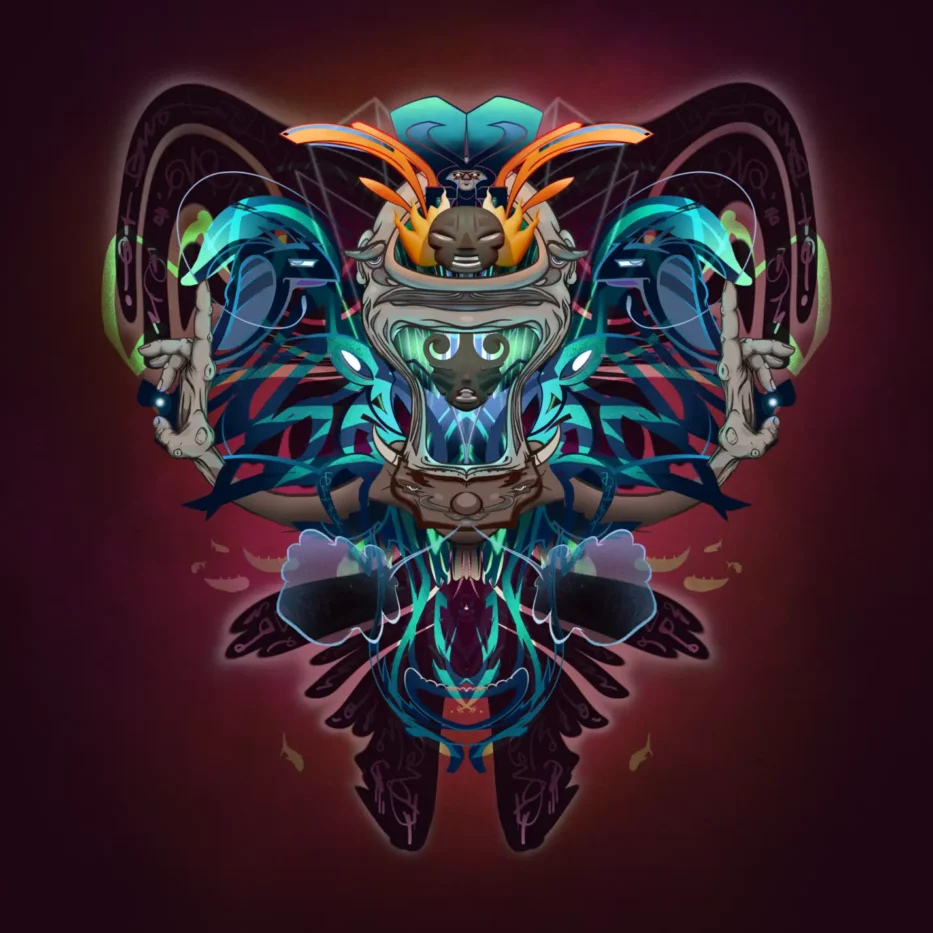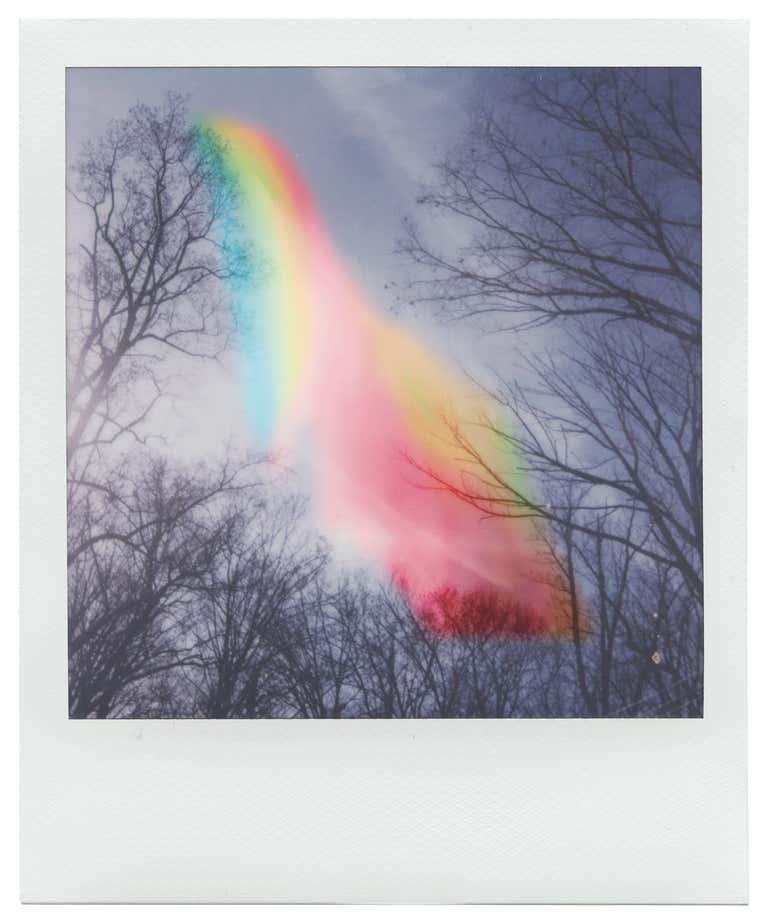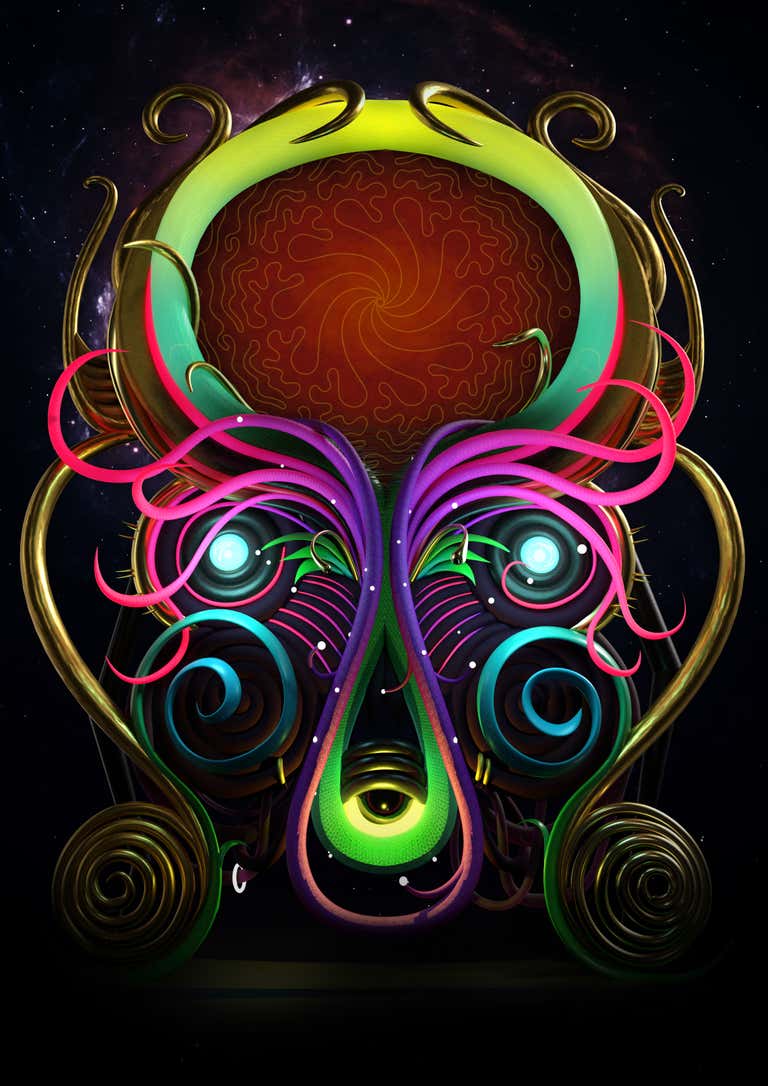Visionary artists are often perceived as existing between worlds, coming from one to another freighted with precious, possibly numinous experiences. Aldous Huxley in The Doors of Perception — perhaps the best advertisement for hallucinogenic drugs ever written — describes William Blake’s talent not in his ability to see the cherubim of his visions but to “express, in literary or plastic symbols, what he has seen.”
Huxley interpreted his experiences with peyote as a kind of tourist pass to a world of the mind that artists like Blake inhabited year-round. Indeed, the term psychedelic, as coined in the 1950s by the British psychiatrist Humphry Osmond (the man who provided Huxley with the peyote that occasioned the experiences described in The Doors of Perception), means literally mind-manifesting.
Perhaps it was inevitable that the NFT space, with its emphasis on the existence of a parallel reality (the metaverse) with its own system of value and verisimilitude, would become a fertile ground for new kinds of psychedelic art, or at least a marketplace for art considered too out-there for the mainstream.
Throughout his life the digital artist Lee Mason, aka Metageist, has experienced vivid and unusual dreams. He describes the sinister, black-eyed character that he uses as his avatar as a “very direct representation of the shadow people I used to see when I would have sleep paralysis as a child.”
These visitations, in which figures would appear sitting on the edge of his bed or even on his chest, left a lasting impression. “I remember them probably better than I remember my neighbors at the time,” he says.
Mason describes his first experience with virtual reality as an epiphany. “It was just like a flash-bulb moment. I knew that this was what I wanted to be working in from now on. And that was before I’d seen any of the art tools,” he says. The doors and gates that he creates using VR brushstrokes in Tilt Brush bring to mind the parochial Romani art of English fairgrounds, invitations to step on to a ride, thresholds to new kinds of experiences.
Mason advocates a version of simulation theory, the idea that our experience of the world is probabilistically more likely to be occurring within a simulation than not. In fact, he regards all experience as a kind of simulation, drawing no distinction between his virtual and real life.
“I am experiencing a simulation that my brain is very cleverly putting together from like six or seven electrical signals,” he says. In this respect, talking to the artist feels like encountering the forerunner of a new attitude to the digital, whose features we may recognize in ourselves, even if we don’t fully acknowledge them.
Are our digital and “real” lives really as distinct as all that? If you’ve ever maintained a relationship via Zoom or been hurt by a text message such questions should give you pause.
The Romanian painter, sculptor and digital artist Zazulete, who describes herself variously as an “esotericist” and a “witch,” is interested in representing altered states of consciousness arrived at through meditation; colors and textures that she sees as existing in the “astral field.”
Her work references alchemical processes and the occult, and yet it is also infused with a kind of optimism. “It’s a matter of accessing that bridge in the mind,” she says. According to Zazulete, those parts of our brain that remain a mystery to science, far from being a relic of our evolutionary ancestors, are actually dormant structures waiting to be activated, hardware waiting for the right software to fulfill its potential.
“I think that the Golden Age belongs to the future, and it coincides with our gifts relating to new parts of the brain opening,” she says. We will all enjoy this reality one day, she seems to posit, artists such as herself merely have early access.
Bradley Wilson, who goes by the moniker Hidden Forces, creates his work from petri dishes filled with ice, ground gemstones and industrial food dyes. As the mixtures melt, they produce Rorschach-like patterns that the artist films and mints as animated NFTs.
He describes them as “experiments in alluvial flow” or “color battles.” Previously an art director and metal sculptor, exhausted by the cumbersome physicality of his work, Wilson immediately saw the potential of the 30-second NFT format to capture moments in time.
“I’d like them to be sort of portals to a different state of consciousness,” the artist says. “A sort of Zen positioning where you just relax and get carried away with it.”
Perhaps these works speak to what Aldous Huxley, tripping balls, described as a “perpetual present made up of one continually changing apocalypse.” The alluvial process ironically reduced, its storm-in-a-teacup quality analogous to the hallucinogenic experience of seeing the dawn of the universe in the folds of a tie-dyed blanket.
And if all of this seems a bit, well, heady, remember that “mind-manifesting” art can come in more subtle flavors too. There is a gentle charm to the work of Jennifer Panepinto, whose handle is QuantumSpirit, in which rainbows gently twinkle over the surface of Polaroid images of bare trees in silhouette against cloudy skies. The photos have the mood of a walk in the park on day release from rehab, magical and melancholy at the same time.
Panepinto, a veteran of a range of mental-health modalities, describes the pieces as an attempt to express the moment-by-moment discipline of returning to gratitude. For her, the Polaroids represent a kind of “Gen-X magic,” while the digital animation and the NFT-ness of the work situates the pieces in our present, Gen Z–led moment.
They are simple visual haikus describing a mental state that would be hard to capture by other means. And, indeed, each of the descriptions embedded within the NFTs are written in haiku form. “It’s meant to be calming and soothing,” she says. “It’s meant to make you go there.”
Eager to avoid their stigmatization, Humphry Osmond described hallucinogens as a “technology,” which he defined as any object that could change a culture’s relationship with its environment.
In this respect, crypto art’s relationship with psychedelic realms is more than metaphorical. Like psychedelics, NFTs are a technology that sharply divides people: Evangelists see a new world enabled through contact with the universal consciousness of the blockchain, while skeptics hold that the whole thing is dangerous, a collective bad trip that has driven thousands of otherwise sane and normal people totally mad. There’s also that familiar communication problem: How to describe an ineffable experience to someone who has never had one?
The heads and squares have never been more divided.
Lee Mason used to write the words “Are you dreaming?” on his hand and check it regularly throughout the day. Sometimes, he says, “you check and the words are just swimming around, and you go, Oh! I’m dreaming.” Those of us who remain open-minded might well feel that we are on the edge of what promises to be a long, strange trip.



